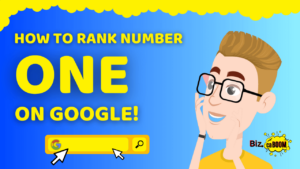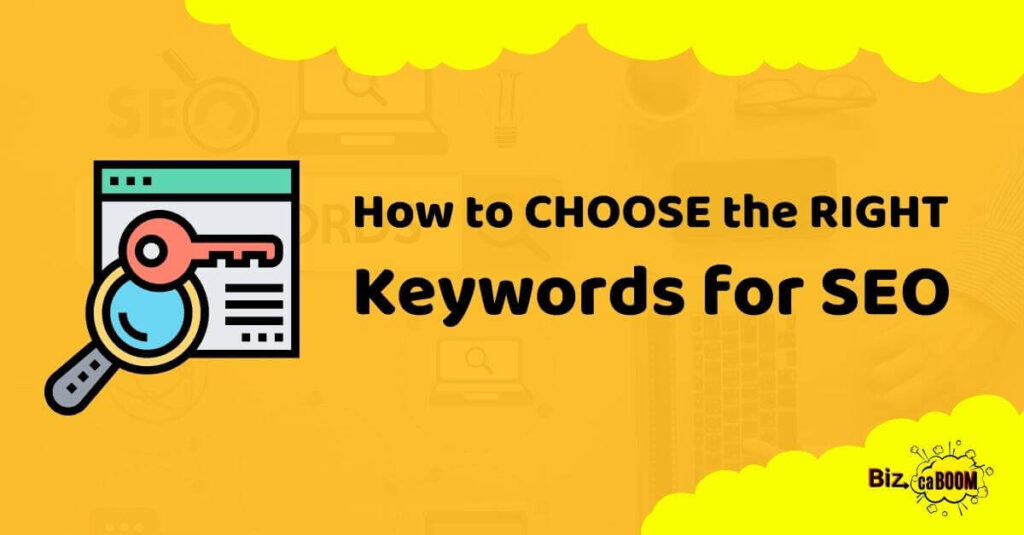
How to Rank Number One on Google
How to Rank NUMBER ONE (#1) on GOOGLE | BizcaBOOM The goal of getting to the top of Google’s number one search results is something

One of the most critical aspects of good search engine optimization is choosing the correct keywords and keyword phrases (SEO) and in this article you’ll learn exactly how to choose the right keywords for SEO.
Your site’s traffic is important, but getting the proper customers is essential. To connect with your target audience, you’ll need to spend some time and effort figuring out which keywords are most effective. SEO and content optimization have relied on keyword research since the beginning, and email marketing will benefit from it as well.
However, deciding on the best search phrases for Google might be a challenge. A lot has changed in search behavior and criteria over the previous few years, and they’re always evolving.
So let’s dive into choosing the right keywords for SEO purposes:
Keywords and phrases that people type into search engines or words and phrases that characterize the topics you write about are examples of SEO keywords. If this is the ideal world, these keywords would help your audience find your material by bridging the gap between the two of you.
For web pages, content production, and marketing purposes, keyword research is the process of determining what people type into search engines.
An SEO service might be hired to conduct keyword research if you have a large marketing budget. SEO experts conduct keyword research on a daily basis and have invested in pricey software licenses to gain access to more advanced information. It’s possible to undertake keyword research with SEMRush, Ahrefs, and Majestic, but they’re all pricey tools. The first step in any successful SEO campaign is to conduct thorough keyword research. Use a site like Upwork to find a freelance SEO expert if you has a smaller budget. However, the quality of work will vary and you will have to spend some time choosing and managing a qualified freelancer. This is cheaper than utilizing an agency.
SEO’s most critical component is keyword research. When determining the order in which content appears in search results, Google considers keywords to be a significant SEO ranking element.
Get them correctly because Google will be able to tell what your content is about, and if you don’t have the right keywords in your content or you’re not targeting the right keywords, you’re not going to get much traction on Google.
Some people question whether or not keyword research is worthwhile. One of the goals of keyword research in the past was to cram content with keywords that people were searching for in order to artificially raise pages to the top of search results. There were times when quality was viewed as less significant than a particular number of keywords in a given piece of material. Such methods are no longer effective. This practice is more typically punished than rewarded. As a result, Google’s search algorithms are always being improved in an effort to better serve users.
In the tutorial, we’ll go into greater detail, but here are a few things to keep in mind:
These keywords or phrases are used by the search engine giant to discover relevant results. The goal is to increase the volume of targeted visitors to a website. Below, some helpful advice on how to choose the best keywords.
A person’s search intent helps determine what keywords they should choose. In total, they’re broken down into three groups:
To get the greatest results, you need to think like a customer while selecting keywords. Water heater broken searches are considerably different from those for “purchase cheap water heater.” One is a commercial key phrase, while the other is educational in nature.
With the purpose of completing your call-to-action, it’s best to provide material in all three sections (CTA). Different landing pages or web pages dedicated to a specific search phrase will be targeted as a result of that keyword. If you’re doing an informational search, supply some unique content relating to that phrase.
Blog posts are ideal for this type of search since they can include multiple keywords. Links to product pages or contact forms are naturally required. Although commercial and transitional purposes are the most straightforward to concentrate on, the market for these is quite competitive. That’s why it’s a good idea to hire an SEO Agency to produce the copy for your website.
Consider the normal path taken by a potential consumer from the moment they learn about a product to the moment they buy it. If you’re in a high-ticket business, you’ll find that most customers won’t make a purchase on the first time they hear about your website. A variety of different stages, such as consideration and decision may be involved in the process. The buyer’s journey is a term used in the marketing industry to describe this process.
In order to attract new customers, you must first gain their attention. Potential clients at the awareness stage may not even have a term for their problem—they are simply aware of it. An office worker, for example, may notice an ache in their wrist while at work, but may not know what the problem is.
Customers begin to identify their issues at this phase, and they begin searching for suitable solutions. If our office worker continues to suffer from wrist pain, they may contact a doctor and learn that they have RSI. It is at this point that you must make a definitive decision. It’s when a potential consumer narrows down a big list of viable solutions and chooses one. It is our goal as marketers to get customers to buy our product rather than a rival one. A gel mouse mat and an ergonomic keyboard can be on the shopping list of an office worker. In addition, they’ll need to select on a brand and a location for their purchase.
Thinking about your audience and where they are on the buyer’s journey might help you better arrange your content. A company that makes ergonomic keyboards may produce a blog article about RSI that is aimed at those who are just beginning to learn about the condition. This blog article may close by encouraging readers to join up for a newsletter that provides special deals for those in the decision-making process.
As you conduct keyword research, you should keep an eye on the competition for a specific phrase. Simply typing a keyword into Google or another search engine and seeing what comes up is the easiest method for assessing competitiveness.
Ads should be the first thing you look for. Ads and sponsored content are both marked with the “Ad” or “Sponsored” tags in Google. When developing a large piece of content, it’s a good idea to check out the ad landscape first to see if it’s worth the effort.
Search engine results pages (SERPs) for your chosen term should be examined as well. What percentage of the content on this page is sponsored by well-known companies? Even if so, it is unlikely to capture the top rank with its first blog post.
Last but not least, have a look at the data. Do you think the content can be beaten? How do you generate material that the average searcher will find more valuable than the current top results? Short, poorly formatted, and lacking in important information are all characteristics of weak content. Be the best at what you do and you’ll rise to the top of the search results.
It was recently revealed that one of the authors at Exposure Ninja was having difficulty getting her blogs to rank for a certain customer. Furthermore, someone else had developed two blogs for the same client’s site, and their content had already begun to rank in search results. Initially, Alex, the initial author, was distraught.
I promised Alex that I’d have a look at the problem, and I quickly discovered it. As always, her writing was wonderful, but she had not included enough photographs in each blog. In the fashion sector, a picture is worth a thousand words, and the client was selling clothing. Excellently written text without accompanying visuals just does not match the needs of searchers attempting to learn about fashion.
Even though it may appear clear from a distance, this example shows how important it is to determine the suitable content format for your target keyword. There’s a lot more to it than that. Decide whether your content is best conveyed by graphs, lists or tables; charts; maps; info graphics; or a slew of photos. An online service like Buzzsumo can help you determine the most popular content types in a specific market.
Map each target term to a specific page on the website as part of the process. A simple content schedule is the greatest method for organizing thoughts. Using a content calendar is beneficial for two reasons:
As a general rule, you should ensure that each of your web pages focuses on distinct and targeted keywords. Typically, you’ll want to target keywords with a lot of commercial intent on your product and service sites. Informational keywords might be targeted in blog postings. Your website should not be targeting the same term in more than one place.
Before diving into keyword research, think about the three different types.
One or two words long, head keywords provide a massive amount of search results. There are 1.17 billion results for the search term “birthday cards” on Google. Two to three words are the typical length of a body keyword. Using Google to search for “mother birthday cards” now returns over 3 million hits.
Three to five word sentences are known as “long tail.” They are employed by most individuals because they offer findings that are more specific. Head keywords are extremely difficult to rank for. The long tail, on the other hand, is easier and more productive.
Finding a good starting point for keyword research is an essential part of a successful keyword strategy. With the help of a simple Google search, you’ll be able to discover what keywords work and which ones don’t. It is possible to see how many people have searched for the terms over time. The site also provides traffic counts for similar terms. A company can incorporate the catchphrases that are most effective into your advertising strategy. This list can be used to aggregate relevant keywords for use in your search engine optimization (SEO) efforts.
There are also semantic keywords, which are closely linked to latent semantic indexing (LSI). An example of LSI is a search engine that uses word association to determine what it truly wants to find.
A word association technique known as Latent Semantic Indexing (LSI) is a complex approach to express the idea. LSI is used by Google to provide relevant results based on context. When you enter keywords into a search engine, the engine tries to figure out what you mean. To show this, type a term into Google and see what comes up. The autocomplete menu offers results depending on the terms you type in the search box. You’ll see that the phrases you’ve typed so far will vary over time. The reason for this is that as your long-tail search grows, Google discovers more possibilities. The bottom of the screen will show related searches as well, as well. Using these semantic or related phrases can help you narrow down your keyword list. Use them to your advantage, as they have been deemed vital by Google.
In the case of “Titanic,” the search engine would use the context you provide with other search phrases to determine if you’re seeking for information about the ship or a box office hit..
An effective keyword research method includes researching LSI keywords to employ in your content because LSI helps search engines give more relevant results when people search. See what LSI looks like in action! Check out Google’s autocomplete results as soon as you start typing something into the search box. As you add terms to describe the situation, this list will be updated.
At the bottom of your search results page, you’ll find a list of related terms that you can use. This list is gone if you modify your search settings.
LSIGraph is a helpful tool for finding LSI keywords because it provides a longer list than Google does. You may find yourself scratching your head at certain articles, while others will provide a eureka moment for your content development process. Using semantic keywords expands the reach and relevance of your material.
Travel websites such as TripAdvisor, Yelp, and even Google Maps show ratings from previous customers on search results pages. Make sure you encourage your customers to leave feedback by using testimonials or a survey link on your website.
You should also respond to every review that comes in because it is a great opportunity for potential customers to learn more about your Houston business. Responding to reviews also tells Google that you’re a reputable business in the Houston area.
Want to Seriously Increase Your Traffic and Rankings on Google?

If you ever need a helping hand in getting your Houston company at the top of Google, look no further and book a call with BizcaBOOM, an SEO Company in Houston, so that you can get more calls coming in. Or if you’re in need of a professional web designer in The Woodlands, feel free to contact us here.
Now that you have learned how to rank your Houston business higher on Google Maps, why not share this post with your friends?
Spread the word out so we can continue to give you valuable SEO content!
Recent Articles:

How to Rank NUMBER ONE (#1) on GOOGLE | BizcaBOOM The goal of getting to the top of Google’s number one search results is something

How to Choose the Right Keywords for SEO Purposes | BizcaBOOM One of the most critical aspects of good search engine optimization is choosing the

Is SEO Better than Google Ads? SEO vs Google Ads Many businesses use marketing techniques such as search engine optimization (SEO) and Google Ads to

How to Rank NUMBER ONE (#1) on GOOGLE | BizcaBOOM The goal of getting to the top of Google’s number one search results is something

How to Choose the Right Keywords for SEO Purposes | BizcaBOOM One of the most critical aspects of good search engine optimization is choosing the

Is SEO Better than Google Ads? SEO vs Google Ads Many businesses use marketing techniques such as search engine optimization (SEO) and Google Ads to
Tell us about your company:
BizcaBOOM is a web design and SEO company in Houston & The Woodlands, TX. We specialize in high-ROI SEO services and web design for small businesses and home service companies. Feel free to give us a call at (832) 605-0924 and let’s help you get more leads, traffic, and exposure!